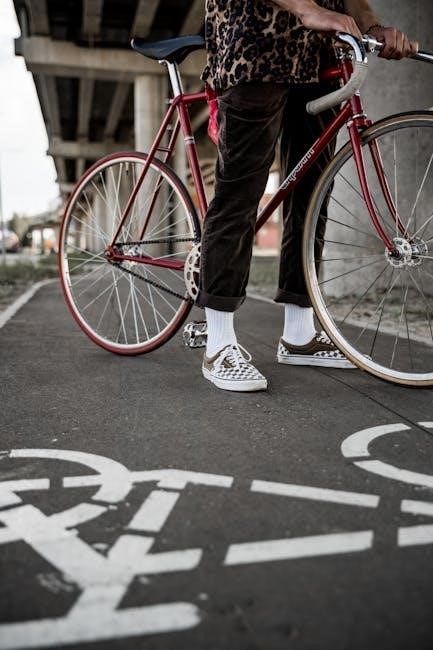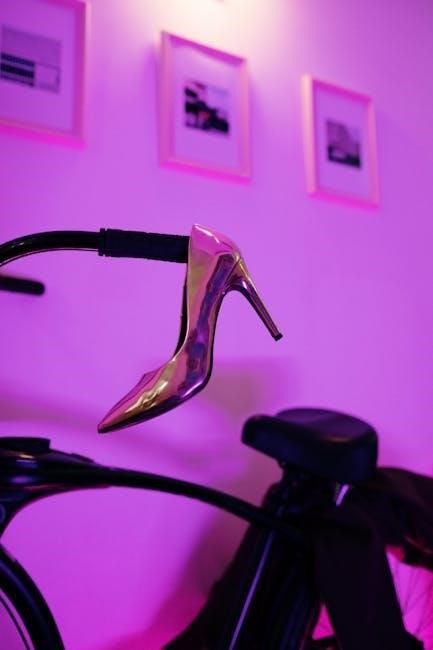Cycling shoes are designed to fit snugly for optimal performance‚ often requiring a smaller size than everyday footwear․ Proper sizing ensures efficiency‚ comfort‚ and prevents discomfort during rides․ Use brand-specific size charts‚ like Shimano’s‚ to find your ideal fit and enhance your cycling experience․
Why Proper Fit Matters
A proper fit in cycling shoes is crucial for both performance and comfort․ Ill-fitting shoes can lead to discomfort‚ numbness‚ or even injury during long rides․ A snug fit ensures optimal power transfer and efficiency‚ as your feet stay securely in place․ Properly fitted shoes also reduce foot movement‚ minimizing the risk of hotspots and blisters․ Additionally‚ a well-fitting shoe provides the necessary support for aggressive or endurance riding‚ enhancing overall performance․ Ignoring fit can result in decreased riding enjoyment and potential health issues․ Therefore‚ prioritizing the right size and fit is essential for a safe and enjoyable cycling experience․

Factors Influencing Bike Shoe Size
Foot measurement‚ brand differences‚ riding style‚ and personal comfort preferences are key factors influencing bike shoe size․ Proper fit enhances performance‚ safety‚ and overall riding experience․
Foot Measurement and Its Importance
Accurate foot measurement is crucial for selecting the right bike shoe size․ Measure your foot length and width to ensure proper fit‚ as cycling shoes are designed to be snug․ Use tools like a Brannock device or ruler for precise measurements․ Foot shape and size vary‚ so measuring at the end of the day ensures the best fit; Proper measurement prevents discomfort‚ numbness‚ or inefficiency during rides․ It also helps in using brand-specific size charts effectively․ Foot width is often overlooked but significantly impacts comfort․ Measure both feet‚ as they may differ slightly․ This step is essential for optimal performance‚ safety‚ and comfort while cycling․ Always prioritize accurate foot measurement for the best fit․
Brand Differences in Sizing

Brand-specific sizing is a critical factor in choosing cycling shoes․ Different brands use unique last shapes‚ which are molds that determine the shoe’s fit․ For example‚ Shimano and Specialized have distinct sizing charts‚ reflecting variations in shoe design and intended use․ Some brands cater to narrower feet‚ while others accommodate wider feet․ This variability means the same size can fit differently across brands․ It’s essential to consult each brand’s size chart and consider personal fit preferences․ Ignoring brand-specific sizing can lead to discomfort or poor performance․ Always compare your foot measurements to the brand’s chart and read reviews for insights into how a particular brand’s sizing runs․ Proper fit ensures optimal performance‚ safety‚ and comfort during rides․
Riding Style and Shoe Fit
Riding style significantly influences the fit of cycling shoes․ Road cyclists often prefer a snug‚ precise fit to maximize pedaling efficiency and power transfer․ Mountain bikers may opt for a slightly roomier fit to accommodate thicker socks and provide more comfort during long‚ rough trails․ Casual or recreational riders might prioritize flexibility and comfort over extreme stiffness․ The type of cleat system and shoe stiffness also vary based on riding style․ For instance‚ clipless shoes for road biking are stiffer‚ while mountain bike shoes offer more flexibility․ Understanding your riding style helps in selecting the right balance of fit‚ support‚ and flexibility․ Proper fit ensures optimal performance‚ comfort‚ and safety‚ regardless of your cycling discipline․ Always consider how and where you ride when choosing your shoe fit․
Personal Comfort Preferences
Personal comfort preferences play a crucial role in selecting the right bike shoe fit․ Some cyclists prefer a snug fit for optimal performance‚ while others prioritize roominess for comfort‚ especially during long rides․ Sock thickness can influence fit‚ with thicker socks requiring more space․ Additionally‚ personal preferences for arch support‚ cushioning‚ and ventilation vary widely․ Riders with specific foot shapes or conditions may need shoes with customizable insoles or extra width․ Brands often cater to these preferences‚ offering models with varying levels of stiffness‚ padding‚ and breathability․ Balancing performance needs with personal comfort ensures a more enjoyable and effective cycling experience․ Always consider individual comfort priorities when choosing your shoe fit to maximize satisfaction and riding efficiency․

Understanding Bike Shoe Size Charts
Bike shoe size charts vary by brand‚ often differing in length and width․ European and US sizing can differ significantly․ Using conversion charts helps determine the best fit․ Each brand’s chart may vary‚ so comparing multiple sources ensures accuracy․
How to Read a Size Chart
Reading a bike shoe size chart involves matching your foot measurement to the corresponding size․ Start by locating your foot length in centimeters or inches․ Compare it to the chart‚ noting the recommended size․ Pay attention to whether the chart uses European or US sizing‚ as these can differ․ Some charts include width options‚ so ensure your foot width aligns with the measurements provided․ If unsure‚ use conversion charts to translate your size between brands or regions․ Dual sizing (e․g․‚ EU/US) on charts can help verify accuracy․ Always check if the chart is specific to road‚ mountain‚ or casual shoes‚ as styles may vary slightly․ This step-by-step approach ensures a precise fit․
Comparing Brands: Variability in Fit
Each cycling shoe brand offers distinct fits due to differences in shoe lasts and design philosophies․ For instance‚ Shimano may fit differently compared to Specialized or Fizik‚ even in the same size․ This variability means that a size 42 in one brand might not fit the same as a size 42 in another․ Some brands cater to narrower or wider feet‚ while others prioritize a roomier toe box․ To navigate this‚ consult the specific brand’s size chart and consider foot width alongside length․ If possible‚ try shoes on or refer to reviews to gauge how a brand’s fit aligns with your foot shape․ This ensures a more accurate and comfortable fit tailored to your cycling needs․
European vs․ US Sizing
European and US sizing systems differ significantly‚ impacting bike shoe fit․ European sizes are typically larger by about 1․5 to 2 sizes compared to US sizes․ For example‚ a US size 9 often corresponds to a European size 42 or 43․ This discrepancy arises from distinct measurement standards‚ with European sizes tending to accommodate longer and sometimes narrower feet․ It’s crucial to refer to the manufacturer’s conversion charts to align your US size with the correct European equivalent; Ignoring this difference can lead to ill-fitting shoes‚ affecting comfort and performance․ Always double-check the size chart provided by the brand to ensure an accurate fit and avoid sizing mismatches when ordering cycling shoes․
Choosing the Right Type of Cycling Shoe
Selecting the right cycling shoe depends on your riding style and terrain․ Road shoes offer stiffness for efficiency‚ while mountain bike shoes provide traction for off-road adventures․ Casual shoes blend comfort and versatility‚ making them ideal for recreational rides․ Each type is designed to optimize performance‚ comfort‚ and durability for specific cycling needs․
Road Cycling Shoes
Mountain Bike Shoes
Mountain bike shoes are designed for off-road adventures‚ offering durability and traction on rough terrain․ They typically feature sturdy soles with aggressive tread patterns for better grip when walking or hiking with your bike․ Many mountain bike shoes are compatible with clipless pedals‚ providing a secure connection for improved control during technical rides․ These shoes often have reinforced uppers for protection against debris and weather-resistant materials to handle muddy or wet conditions․ Breathability is also a key feature‚ ensuring comfort during long‚ intense rides․ While slightly heavier than road shoes‚ mountain bike shoes prioritize functionality and resilience‚ making them ideal for trail and endurance cycling․ Proper fit is crucial to maintain both performance and comfort on the trails․
Mountain bike shoes are designed for off-road adventures‚ offering durability and traction on rough terrain․ They typically feature sturdy soles with aggressive tread patterns for better grip when walking or hiking with your bike․ Many mountain bike shoes are compatible with clipless pedals‚ providing a secure connection for improved control during technical rides․ These shoes often have reinforced uppers for protection against debris and weather-resistant materials to handle muddy or wet conditions․ Breathability is also a key feature‚ ensuring comfort during long‚ intense rides․ While slightly heavier than road shoes‚ mountain bike shoes prioritize functionality and resilience‚ making them ideal for trail and endurance cycling․ Proper fit is crucial to maintain both performance and comfort on the trails․
Casual/Recreational Cycling Shoes
Casual or recreational cycling shoes are perfect for leisurely rides‚ commuters‚ or those who prioritize comfort over high performance․ These shoes often feature a more relaxed fit‚ softer soles‚ and breathable materials‚ making them ideal for short to medium-distance rides․ Unlike road or mountain bike shoes‚ casual cycling shoes are designed for versatility‚ allowing easy walking and comfort off the bike․ Many models combine elements of athletic shoes with cycling-specific features‚ such as compatibility with platform pedals or clipless systems․ They are an excellent choice for cyclists who value practicality and ease of use․ Proper sizing ensures a comfortable fit‚ allowing riders to enjoy their cycling experience without discomfort or strain․

How to Measure Your Foot Accurately
To measure your foot accurately‚ use a ruler‚ paper‚ and pen․ Trace your foot‚ measure the longest and widest points‚ and compare to brand size charts for the best fit․
Step-by-Step Foot Measurement Guide
Place a sheet of paper on a flat surface and stand on it with your foot․
Trace the outline of your foot using a pencil‚ ensuring to keep the pen straight․
Measure the length from the back of the heel to the tip of the longest toe․
Measure the width across the widest part of the foot․
Compare these measurements with the size chart for your chosen cycling shoe brand to determine the best fit․
This method ensures accuracy and helps in selecting the correct shoe size for optimal comfort and performance during cycling․
Tools Needed for Measurement
To accurately measure your foot for cycling shoe sizing‚ you will need a few simple tools:
- A flat‚ hard surface to stand on․
- A ruler or measuring tape to capture length and width․
- A sheet of paper to trace your foot outline․
- A pencil to draw the outline of your foot․
Optional tools include a digital foot scanner for precise measurements or a clipboard to hold the paper steady․ For the most accurate results‚ measure your foot while wearing the same type of socks you plan to use with your cycling shoes․ These tools will help ensure you get the right fit for optimal comfort and performance․
Tips for Accurate Measurement
For precise foot measurement‚ stand on a hard‚ flat surface and wear the same socks you plan to use with your cycling shoes․
- Measure your foot in the afternoon‚ as feet tend to swell slightly during the day․
- Use a ruler or measuring tape perpendicular to your foot to measure length and width․
- Trace the outline of your foot on paper to visualize the shape and fit․
- Take multiple measurements to ensure accuracy and consistency․
- Consider both feet‚ as they may differ slightly in size․
By following these tips‚ you can achieve an accurate measurement‚ ensuring the best fit for your cycling shoes and enhancing your riding comfort and performance․

Using Brand-Specific Size Charts
․each brand offers unique sizing charts‚ like Shimano’s‚ to help determine your ideal fit․ Always refer to the manufacturer’s guide for accurate size selection and optimal comfort․
Shimano Size Chart Example
Shimano offers detailed size charts to help cyclists find the perfect fit․ Their charts typically include EU‚ US‚ and UK sizes‚ providing a clear conversion guide․ For example‚ a foot length of 27․3 cm corresponds to a size 44‚ while 25․8 cm aligns with size 41․5․ Shimano’s charts often account for both length and width‚ ensuring a snug yet comfortable fit․ They emphasize that cycling shoes should fit tighter than casual shoes‚ as this enhances pedaling efficiency and support․ When using Shimano’s size chart‚ measure your foot accurately and consider the specific shoe model‚ as slight variations may occur․ This ensures the best fit for optimal performance and comfort during rides․
Specialized vs․ Other Brands
Specialized cycling shoes are known for their precise fit and ergonomic design‚ often catering to performance-oriented riders․ While brands like Shimano and Crankbrothers focus on versatility‚ Specialized emphasizes a tailored fit‚ particularly in their higher-end models․ For instance‚ the S-Works series offers a snug‚ race-ready feel‚ whereas Shimano might provide a slightly roomier toe box․ Riders who prefer a more customized fit often lean toward Specialized‚ while those needing adaptability might choose other brands․ Comparing size charts and trying shoes on is crucial‚ as each brand’s last and design philosophy can vary significantly‚ affecting comfort and performance during rides․
How to Use Conversion Charts
Conversion charts are essential for determining your bike shoe size‚ especially when switching brands or styles․ Start by locating the brand’s official size chart‚ usually found on their website․ Match your measured foot length to the corresponding size‚ ensuring to account for snug fit preferences․ For example‚ Shimano’s chart aligns EU‚ US‚ and UK sizes‚ helping you cross-reference․ Consider width options‚ as some brands offer multiple widths․ When converting between EU and US sizes‚ note that EU sizes are numerically higher․ Always double-check the chart specific to the shoe model‚ as sizing can vary slightly between lines․ Testing the fit in person‚ if possible‚ ensures accuracy and comfort‚ while online reviews can provide insights into real-world sizing experiences․

Common Mistakes in Sizing
Common mistakes include ignoring foot width‚ not considering personal fit preferences‚ and assuming all brands fit the same․ These oversights can lead to discomfort and poor performance․
Ignoring Foot Width
One of the most frequent mistakes cyclists make is ignoring foot width when selecting bike shoes․ While many focus solely on length‚ a shoe that doesn’t accommodate the foot’s width can cause discomfort‚ blisters‚ and even affect performance․ Narrow shoes can compress toes‚ leading to discomfort‚ while overly wide shoes may not provide the necessary support․ Brands often offer varying widths‚ so it’s crucial to check both length and width measurements․ Using a size chart that includes width can help ensure a better fit․ Additionally‚ some brands offer customizable insoles to cater to different foot shapes‚ further enhancing comfort and support during rides․
Not Considering Personal Fit Preferences
Personal fit preferences are crucial when selecting bike shoes‚ as every cyclist’s comfort needs differ․ Some riders prefer a snug fit for maximum performance‚ while others prioritize a looser feel for comfort during long rides․ Ignoring these preferences can lead to discomfort‚ fatigue‚ or even pain․ Factors like toe room‚ heel snugness‚ and overall tightness should align with individual riding styles and durations․ For instance‚ a road cyclist may opt for a tighter fit for efficiency‚ while a casual rider might prefer more flexibility․ It’s essential to test shoes in person or refer to brand-specific fit guides to ensure the chosen size matches personal comfort expectations‚ enhancing overall cycling satisfaction and performance․
Assuming All Brands Fit the Same
A common mistake is assuming all cycling shoe brands have consistent sizing‚ but this is far from true․ Each brand uses different lasts‚ or molds‚ to shape their shoes‚ leading to variations in fit․ For example‚ Shimano shoes might fit differently compared to Specialized or Fizik due to differences in design and materials․ Riders may find their usual size too tight or too loose depending on the brand․ Consulting brand-specific size charts and reading reviews can help navigate these discrepancies․ It’s also wise to try shoes on if possible‚ as relying solely on a standard size can lead to an ill-fitting purchase․ Understanding these variations ensures a better fit and improved performance during rides․ Always verify fit across brands to avoid potential discomfort․

Importance of Trying Before Buying
Trying cycling shoes before purchasing ensures proper fit‚ comfort‚ and performance․ Ill-fitting shoes can cause discomfort and hinder performance‚ making in-store fittings highly recommended for accuracy․

How to Test Shoe Fit
Testing shoe fit involves ensuring a snug yet comfortable feel․ The shoe should not be too tight or too loose‚ with adequate room for toes and a secure heel․ Check for proper width and length‚ ensuring about a half-inch of space in the toe box․ The heel should be snug to prevent movement during pedaling‚ and the overall support around the arch and sides should feel comfortable․ Consider the closure system‚ whether it’s laces‚ Velcro‚ or BOA dials‚ for ease of adjustment․ Additionally‚ evaluate the shoe’s compatibility with your pedals and the cleat position for optimal power transfer․ Trying shoes with the same socks you plan to wear while cycling is also important‚ and seeking a professional fitting can help ensure the best fit for your cycling needs․
What to Look for in a Test Fit

When testing shoe fit‚ prioritize comfort and performance; Ensure the shoe feels snug but not tight‚ with adequate room for toes and a secure heel․ Check for proper alignment of the cleat with the pedal‚ as misalignment can lead to inefficiency or discomfort․ The shoe should provide solid support around the arch and sides‚ while the width should accommodate your foot without pressure․ Pay attention to the closure system—laces‚ Velcro‚ or BOA dials—ensuring it holds your foot firmly without causing hotspots․ Also‚ assess the shoe’s flexibility and stiffness‚ as these factors impact power transfer during pedaling․ Finally‚ walk around to ensure the shoes feel comfortable off the bike‚ as this can indicate long-ride comfort․
Benefits of In-Store Fittings
In-store fittings offer personalized guidance from experienced staff‚ ensuring a precise fit tailored to your foot shape and riding style․ Experts can measure your feet‚ assess your arch type‚ and recommend the best shoe models for you․ Trying on multiple brands and sizes allows you to compare comfort‚ support‚ and performance directly․ Additionally‚ in-store fittings often include cleat alignment services‚ optimizing your pedal efficiency and reducing injury risk․ The immediate feedback from professionals can prevent sizing mistakes and enhance your overall cycling experience․ This hands-on approach ensures you leave with the perfect pair‚ boosting both comfort and performance during rides․
Proper bike shoe sizing is crucial for performance and comfort․ Always measure your feet‚ use brand-specific charts‚ and test shoes in-store․ Prioritize fit‚ support‚ and personal comfort to enhance your cycling experience․
Proper bike shoe sizing is essential for optimal performance‚ comfort‚ and injury prevention․ Factors like foot measurement‚ brand differences‚ riding style‚ and personal comfort preferences must be considered․ Using brand-specific size charts and conversion guides helps ensure accurate fitting․ Avoid common mistakes such as ignoring foot width‚ assuming all brands fit the same‚ and not considering personal preferences․ Testing shoes in-store is highly recommended to confirm fit and feel․ Prioritizing support‚ stiffness‚ and a snug but comfortable fit will enhance your cycling experience․ By following these guidelines‚ cyclists can select the right shoes to maximize efficiency and enjoyment on the road or trail․
Final Tips for the Best Fit
For the best fit‚ always measure your feet accurately and consult brand-specific size charts․ Consider your riding style‚ as it influences the required stiffness and support․ Prioritize comfort by ensuring adequate toe room and a snug heel․ Test shoes in-store if possible‚ wearing the same type of socks you’ll use while cycling; Pay attention to width and overall fit‚ as brands vary significantly․ Don’t hesitate to seek professional fitting advice to avoid common mistakes like sizing too tight or too loose․ By combining these strategies‚ you’ll maximize both performance and comfort‚ ensuring an enjoyable and efficient cycling experience․
